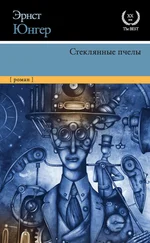ON PAIN
On 25 October, before departing for the Italian front, Jünger’s son Ernstel visited Kirchhorst for the last time. On 27 October, Jünger was formally decommissioned from military service. He returned to his books and his garden, although constant Allied bombing made life difficult and dangerous even in rural areas in Germany.
On 12 January 1945, Jünger received the dreadful news that his eldest son, his namesake Ernstel, had been killed on 29 November 1944 in, of all places, the marble cliffs of Cararra, Italy. The boy had been overheard talking to a friend, Wolf Jobst Siedler (later an important writer and publisher in the Federal Republic), expressing “defeatist” remarks about the Hitler regime. Ernstel was also caught listening to foreign radio broadcasts. A spy denounced both boys, and they were arrested in January 1944. Hitler had recently given orders that fresh recruits (Ernstel was eighteen) were to be trained not only in the best military tactics but also as sharp ideological warriors. The actions of Ernstel and Wolf could therefore have led to death sentences.
Jünger had received permission to leave Paris in February 1944 and met with the authorities in Berlin, displaying his Pour le Mérite medal ostentatiously at his neck. In April, Ernst and Gretha visited the presiding judge in Ernstel’s case, Admiral Scheurlen, [46] Jünger, Second Paris Journal , Kirchhorst, 13 April 1944.
who reduced an initial harsher penalty to Frontbewährung , which meant the boy was allowed to return to military service to prove his worth and was given a dangerous assignment in the Italian mountains. Jünger was never sure whether his son had been shot by the enemy or executed by the SS, with a shot to the back of the neck. [47] Wolf Jobst Siedler, Ein Leben wird besichtigt: in der Welt der Eltern (Munich: Siedler Verlag, 2000), 334. Ernstel’s body was later exhumed and returned to Jünger’s last domicile at Wilflingen, which provided evidence of the supposition that he had been executed.
For the most part, the war journals consist of dispassionate, precise observations, showing little emotion and only limited introspection, as when, for example, Jünger ruminates about his tendency to fall into depression, la frousse . By contrast, for weeks after he and Gretha received news of the boy’s death, he returned repeatedly to ruminating on the poignant pain of losing his eldest son. “I cannot stop thinking about Ernstel. So much about his life is a riddle that is hard to solve.” [48] Jünger, Kirchhorst Diaries , Kirchhorst, 14 January 1945.
The war journals end with Jünger unenthusiastically commanding the local Volkssturm , the national militia of males between sixteen and sixty not already serving in the army, which had been announced by Hitler in the fall of 1944. As refugees streamed through the countryside, some billeted in his house, Jünger retreated as much as possible into his books and letters, hiding out in a garden cottage or upstairs in his attic. Perpetua took command of the household and kept intruders at bay. On 29 March, on his fiftieth birthday, he heard news from his publisher that Goebbels had forbidden mention of his name in the press, “the only honor that I prize.” [49] Jünger, Kirchhorst Diaries , Kirchhorst, 29 March 1945.
His final thoughts in these journals were about his dead son. As he watched American army tanks and other armored vehicles pass by on a road nearby, with jets streaming overhead, a “parade of dangerous toys,” he sensed the “incursion of a superpower into a completely crushed region.” [50] Jünger, Kirchhorst Diaries , Kirchhorst, 11 April 1945.
The only saving grace, at least Ernstel did not see this, for “it would have hurt him too much.”
THEMES AND FORMS
As important as historical context is for a full appreciation of these war journals, it is necessary before concluding to pay some attention to Jünger’s idiosyncratic style. Nothing derogatory is meant by the term “idiosyncratic,” deriving from the Greek words “idio” and “sunkratikos,” or mixed together in a way particular to an individual. An “idiot” in Greek was someone who did not participate in the public sphere, but by inference was someone who took a singular path. Jünger was certainly no idiot, but he did very much march to the beat of his own drum. His depth of experience and knowledge was astounding, especially considering that he was still in his late forties when he wrote these journals. Furthermore, he was an autodidact who, despite some university study, lacked specialized academic training. Very few observers could have predicted at the time that by the 1980s he would be compared to Goethe. [51] See Neaman, A Dubious Past , chap. 7.
The journals give many indications of why that judgment was not off the mark, not only because of the bountiful evidence of polymathy but also because of Jünger’s unique style and form. The following sections briefly address three key aspects of his writing that are essential for revealing the inimitable fabric, the texture that links words to reality in these pages.
1. Thematic: Adventure
Jünger’s thirst for adventure was played out in his short stint in the French Foreign Legion and his four-year, life-changing service in the Great War. It was also imaginary, as in his reflections on books, dreams, plants, and animals. These offer a key that can unlock many of Ernst Jünger’s writings. In these war journals, for example, Jünger returns repeatedly to adventure books about shipwrecks, a metaphor for the situation in which he finds himself, logging the events leading to the inevitable downfall of Germany.
Adventure is perhaps the oldest of all literary genres. Gerhard Nebel, who worked as a translator in Paris in 1941 and is mentioned in the war journals, explored the concept in his early post–World War II book, describing Jünger’s spiritual and metaphysical thirst for adventure as the glue that holds together such disparate endeavors as militant nationalism and Christian spiritualism. [52] See Gerhard Nebel, Ernst Jünger: Abenteuer des Geistes (Wuppertal: Marées Verlag, 1949). Nebel is mentioned thirteen times in the war journals and was a trusted confidante. See Jünger, First Paris Journal , Paris, 11 October 1941, in which Jünger discusses with Nebel “the matter of the safe.”
Gerhard Loose also picked up the adventure theme in his Jünger biography, emphasizing the pitfalls inherent in the cult of self ( Ichbezogenheit ), which reduces the natural world, foreign lands, war, or just about any phenomenon to objects of speculation for Jünger’s aesthetic imagination.
In one of the most insightful essays ever written on the topic, the sociologist Georg Simmel defined the adventure as a self-contained experience, without reference to all the neighboring parts of life: “it is like an island in life, which determines its beginning and its end according to its own visionary powers ( Bildungskräfte ), and is not at the same time determined, as in the case of a part of a continent, by the one side or the other.” [53] See Georg Simmel, Philosophische Kultur: Über das Abenteuer, die Geschlechter und die Krise der Moderne (Berlin: Wagenbach, 1983), 14.
Both world wars were (by Simmel’s definition) islands in Jünger’s life, and both provided ample material for his visionary imagination.
2. Form: Stereoscopy
In the mid and late 1930s, Jünger’s adventures continued, but in a different key. In 1934 he published a collection of essays, Leaves and Stones , which marked a turn away from militant politics. The collection contained a travel diary, an essay on pain, a surrealist take on the “Man on the Moon,” and a piece on language, “In Praise of Vowels.” The volume also contained theoretical tracts on military subjects, in particular a reprint of “The Total Mobilization.” He revised The Adventurous Heart , which in tone and substance was so distant from the kind of literature published in Germany at the time that it might as well have been penned by a foreign author. In 1938 Jünger cut most of the autobiographical details of the first edition and replaced them with metaphysical reflections and dream sequences that would avoid the censor’s blue pencil in Hitler’s Germany. The method was “stereoscopic,” a journey into dreamlike realms below quotidian existence. [54] See the introduction by Eliah Bures and Elliot Neaman in Jünger, The Adventurous Heart , xiii–lii.
Читать дальше
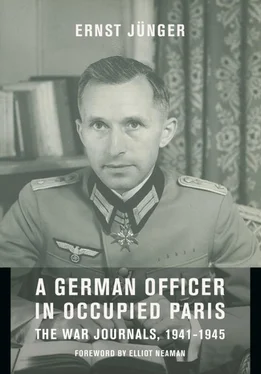
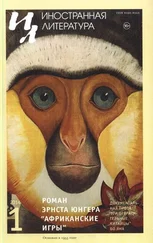
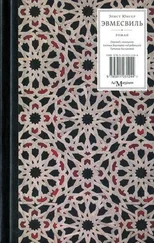


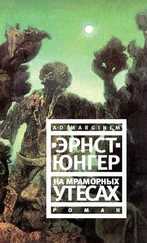
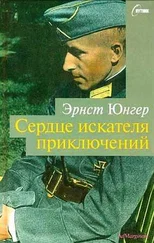
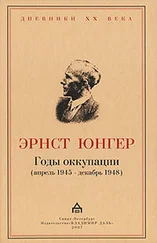
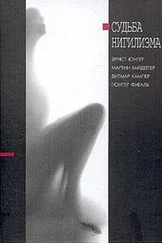
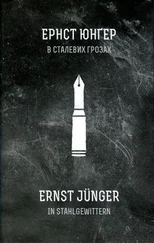
![Эрнст Юнгер - Стеклянные пчелы [litres]](/books/410842/ernst-yunger-steklyannye-pchely-litres-thumb.webp)
